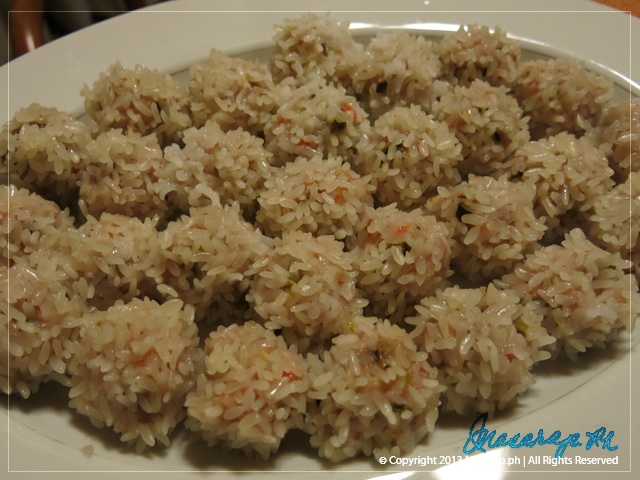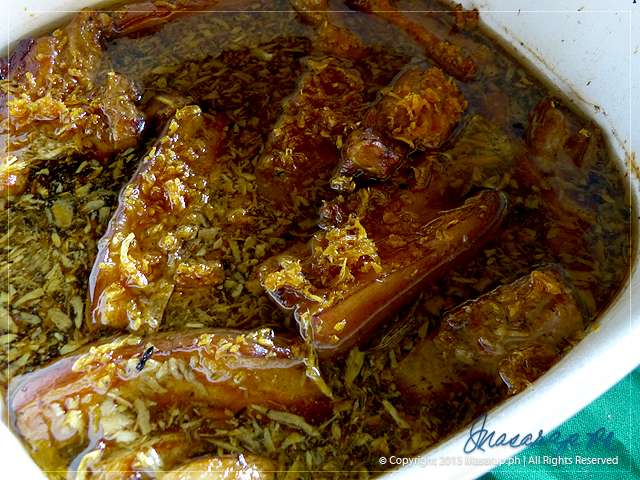As Sofia, from the Golden Girls T.V. series says, “picture this!â€: the sun is setting over the horizon,  in one of the many beautiful beaches in the Philippines; the beer is chilling nearby, ready to slake your thirst; you just caught a beautiful tuna fish early this morning; the fish coruscating on the chopping board as it is prepared for Kinilaw na Isda; the mouth-watering scent of the pork and chicken as they are grilled over an open charcoal fire; and the cooling winds playing tag with the hair and clothes of your family and friends  frolicking on the sand — PICTURE PERFECT! The best way to make this is to have very fresh fish; freshly caught is the most excellent. I like using calamansi juice because of its fragrance and lime can also be used. You can add more vinegar or calamansi juice if you prefer. Procedure: 1 kilo sashimi grade tuna or tanigue (Spanish mackerel) – sliced into 1/4-inch thick by 1 1/2-inch lengths 1 tablespoon sea salt 1 tablespoon finely julienned sliced ginger 1 cup chopped sibuyas Tagalog or red onion 10 – 15 pieces bird eye chilies – finely sliced in circles 1/2 cup calamansi or lemon juice 1/4 cup coconut vinegar or palm vinegar Procedure: Make sure you place the fish in a glass serving dish or enamel dish. This prevents the vinegar from reacting with either stainless or aluminum and keeps the flavor clean. Arrange the fish pieces on the glass dish. Mix all the other ingredients in a glass bowl and taste before pouring in. Adjust the salt or chilies to your liking. When the flavor is right, pour over the fish and stir around. Cover with plastic wrap and refrigerate for about 1 to 2 hours. The fish and marinade will turn milky. This means it’s ready to serve. Serve with cold beer or chilled white...
Appetizers / Pulutan
This Salsa is so delicious on rice, pasta and bread. I got the idea from Salsa Amaya but changed things a sit to suit my blood type AB diet. I also find it a ‘comfort’ food. With my hectic schedule in Manila, sometimes I don’t feel like eating a full meal. I ask my ‘yaya’ Carol Laoreno to cook me some fragrant Jasmine rice and then I mix the Salsa Ana on top of the steaming rice and just savor the homely flavor of the salsa. That’s what I call ‘comfort food.’ This recipe will make  three 300 gram-bottles. Ingredients: 2 tablespoons (25 grams) finely minced garlic 60 grams deboned salted fish (tuyo na Lapad) 2 tablespoons Mirin – cooking Sake 400 grams canned button mushroom – sliced fine 70 grams sun dried tomatoes or 100 grams sun dried tomato in oil – slice thinly julienne 150 grams green pitted olives – sliced fine in round shape 3 cups extra virgin olive oil 1/2 teaspoon salt 1/2 teaspoon pepper Procedure: Sprinkle the deboned tuyo with 2 tablespoons of Mirin and toss. Set aside. In a non stick, heavy bottom cooking pan, pour in olive oil and warm over very low fire. Place the tuyo in the pan and cook the tuyo in the low fire for 20 minutes. Then add in the garlic and continue to cook for 5 minutes; stirring every once in a while. Then add in the dried tomatoes and simmer for another 10 minutes, stirring occasionally. Then add in the olives and simmer for another 10 minutes, stirring occasionally. Then add in the mushrooms and simmer for another 40 minutes, stirring occasionally. Season with salt and pepper. Cool and bottle. Serve with steaming hot rice. Notes: The other way to use this sauce is as sauce for pasta. Tuyo is our version of anchovy sans the oil. I use either spaghettini or twist pasta. Salsa Ana is also good served with crackers or bread, rolls or French bread (toasted or...
The Philippines has been greatly influenced by Chinese cooking since the time of Chinese trading with the Philippines. In fact many Filipinos are partly Chinese; me, case in point is partly Chinese. Siomai or steamed pork dumpling is Chinese in origin. This recipe is Chinese in origin with a slight twist; the exchange of rice in place of wonton wrapper. The reason for this exchange is that sometimes the wonton wrapper gets soggy and looks wilted; whereas the rice makes the Siomai look always fresh. My first encounter with ‘siomai’ was when I was a grade schooler at the Assumption Convent in Manila. The nuns sold these dumplings bought from the famous “Ma Mon Luk†restaurant during the school fairs. Siomai Ingredients: 500 grams ground pork 250 grams shrimps – steamed, peeled and cut into tiny cubes 1/2 cup carrots – peeled, cut into tiny cubes 1/8-inch size 3/4 cup water chestnuts or singkamas – cut into tiny cubes (water chestnuts preferred) 1/4 cup spring onions – finely chopped 1/2 cup pork luncheon meat (Spam) or ham – cut into tiny cubes 3 pieces dried black Chinese mushrooms – soaked in hot water till soft, drained, stems removed, and cut into tiny pieces or 1/2 cup finely chopped fresh Shitake mushrooms 1 teaspoon finely grated ginger 1 tablespoon seat salt 1 tablespoon sesame oil 3 tablespoons oyster sauce 2 tablespoons soy sauce 3 egg whites 1 teaspoon freshly ground black pepper 1 cup cornstarch (corn flour) 1 cup rice – soaked in water for 1 hour and drained or 50 pieces wonton wrappers 1/2 cup frozen green peas (optional for decoration) Siomai Procedure: Wear plastic gloves and, with hands, combine all the ingredients except rice or wrapper and peas, until well blended. With hands, shape mixture into 1 1/2-inch balls and roll in rice until the whole ball is covered with rice. Set aside on a tray until all the balls have been rolled. Place a pea on top of each ball. Arrange the dumplings in single layer in an oiled basket steamer or line steamer basket with ‘katcha’. Have two inches of water in the bottom layer of steamer and bring to a boil. Place the steamer basket on top and steam dumplings for 20 to 30 minutes or until the dumplings and rice are cooked. Serve with the dipping sauce. Dipping Sauce Ingredients: 1/2 cup soy sauce 1 tablespoon calamansi or lemon juice 1/2 teaspoon hot sauce (Tabasco or Chili sauce) 1/4 teaspoon sesame oil 1 tablespoon sugar Dipping Sauce Procedure: Mix together in a small bowl and use as dipping sauce for Siomai. Notes: Wrap the cover of the steamer with ‘katcha’ to prevent the dumplings...
Many moons ago, I first tasted the ‘empanada’ of El Gusto Restaurant on Claro M. Recto Street, I knew I had to come up with a recipe just like it. Sometimes in the middle of the night, I would crave their meat pies and would ask the messenger to get some – it was that good. But they must have changed cooks because lately, only the crust remains the same. It is sad when a good product becomes popular, and then something happens to make it inferior. For most things, quality is still the best standard. This is good for ‘merienda’ (afternoon snack) or light meal. During my catering days, I accepted an order of 1000 pieces of these, and my staff and I worked through the day and night to ready them for delivery. Never again! Makes 25 pies. Ingredients: Filling – 1 1/2 teaspoons crushed garlic 125 grams finely chopped onions 2 tablespoons cooking oil 500 grams ground pork or 250 grams ground pork and 250 grams ground beef 1 tablespoons soy sauce 1 1/2 teaspoons salt 1/2 teaspoons freshly ground black pepper 1/4 cup raisins 125 grams potatoes – cut into 1/4-inch cubes and slightly pan fried Crust: See Empanada Recipe Procedure: In a medium sized wok, placed over medium-low fire, saute garlic and onions in oil until onions are transparent and garlic slightly browned. Add the ground meat, soy sauce, salt, pepper, and raisins. Cook until meat is browned but not dry; turning the meat often till this is done. Add pan friend potato cubes, the reduce the heat to low, stirring occasionally until mixture is dry. Remove from heat and let cool. Prepare crust using Empanada pastry recipe. Cut out pastry into 5-inch diameter circles, using a cardboard pattern as a guide. Repeat with other pieces of dough. For each set of cut pastry, begin to fill them. Divide the meat mixture into 25 equal portions; you can weigh the lot and divide accordingly. Place a portion on one side of the rolled out crust. Brush around edge of crust with a mixture of 1 egg white and 1 tablespoon cold water, lightly beaten. Fold over the crust to make a half moon. Roll the edges, into tiny folds, all around to seal. Brush with egg white mixture or milk, to give it a nice gloss when baked. Arrange pies on greased and floured baking sheet or line baking sheet with baking paper. Leave 1-inch space between pies. Bake in a preheated oven 180ºC or 350ºF for 20 minutes or until the pies are a light golden brown....
Ingredients: 1/2 cup chopped onions 50 grams (3 1/2 tablespoons) butter 2 tablespoons cooking oil 250 grams bacon – sliced into 1/4-inch pieces 250 grams ham – sliced into 1/4-inch pieces 1 whole chicken – boiled till cook, deboned and cut into 1/4-inch cubes 1 small can Vienna Sausage, halved lengthwise, then sliced crosswise into 1/8-inch thick slices (half moon) 1 small can green peas or 100 grams frozen peas and cooked 2 teaspoons salt 1/2 teaspoon freshly ground black pepper 4 hard-boiled eggs – peeled and sliced into 8 half moons Crust: See Empanada Pastry Recipe Mixture for Sealing Pie Edges: 1 egg white 1 tablespoon cold water Mix together well and use to brush edges of pie crust and to brush top of pie. You may also use milk to brush edges and top. Procedure: In a medium wok over medium-low fire, saute onions in butter and oil until transparent. Add bacon and cook until half cooked. Add ham, chicken, Vienna sausage, peas, salt and pepper. Simmer about 10 minutes, stirring occasionally to prevent sticking at the bottom and to blend the flavors. The mixture must be moist but not wet. Remove from fire and let cool. When cool, put 2 tablespoons (for small pies) or 1/4 cup (for bigger pies) of the mixture onto one side of rolled out pie crust. Top with a slice of hard boiled egg. Brush edges with egg-white/water mixture. Fold over the pie crust and seal edges by making small folds around. Brush top with egg-white/water mixture or milk. Arrange pies on a greased and floured cookie sheet or line cookie sheet with baking paper. Bake in pre-heated oven at 175ºC or 350ºF for 15 to 20 minutes or until the crust is a light golden brown. Makes 30 small pies or 25 big pies. The small pies are good for merienda and bigger ones for...
Ingredients: 3 1/2 cups (420 grams) all purpose flour 2/3 cup (130 grams) sugar – you can lessen this 1 teaspoon salt 1 cup sour cream 3/4 cup shortening Procedure: In a medium sized bowl, stir together flour, sugar and salt. Make a well in the center of flour mixture (push mixture up sides of bowl), and pour sour cream and shortening into well. With a pastry blender, or fork and knife, cut sour cream and shortening into flour until particles are the size of peas. Using your hands, shape dough into a ball and knead until smooth. Divide dough into four pieces. Take one piece of dough and cover the rest with plastic wrap or a hand towel, until ready to use. On a lightly floured surface, roll out dough 1/8-inch thick. Cut out 4-inch (for small pies) or 5-inch (for bigger pies) diameter circles, using cardboard pattern as a guide. Gather the left over pieces and roll them out again. Repeat with other pieces of dough. Fill pastry with dough. Seal the edges with egg white/water mixture and make tiny folds all around the pie to seal edges nicely. Notes: Fill per batch of rolled out dough so that the dough does not stiffen. Remember that the dough was divided into four lots. Roll and fill per part of...
Adobo was originally a Spanish dish, having been introduced four hundred years ago, but has become something Filipinos have since adopted and made their own. Indeed, there are as many versions of adobo as there are provinces in the Philippines. Practically each household has its own rendition of this traditional dish, each with its own distinct twist to the recipe. The basic ingredients are garlic and vinegar or another souring agent (tamarind, guava and even watermelon are not unheard of) and soy sauce. Some versions require coconut milk while others use olive oil. The viands required to fill the stew are also as varied. Aside from pork or chicken, one can make adobo with prawns, squid, lamb, goat, crabs, beef, vegetables (bamboo shoots, Chinese cabbage, potato, etc.) or even frog’s legs and balut (traditionally salted duck fetus). Once prepared, it is an invaluable companion to steaming hot rice and makes for a quick meal over the week, as the older it gets, the richer and more full-bodied its flavor. Even adobo’s leftovers need not go to waste. The sauce and oils can be used for frying leftover rice while the meat can be shredded and also fried to a crisp as Ropa Vieja.  Try this recipe if you want something distinctly home-cooked from the Archipelago. Ingredients: 1 kilo pork belly (liempo) and cut into 1-inch width by 2-inch lengths 1/2 cup soy sauce 1/2 cup vinegar 1 cup rum (Tanduay or Añejo, the white variant, you can also use your favorite rum brand) Soak the pork belly pieces in this mixture. 2 tablespoons crushed garlic 2 tablespoons cooking oil Sauté garlic in the cooking oil till light golden brown. Remove garlic from oil and drain on paper towel. 1 cup buco juice (young coconut juice, aka young coconut water) 2 tablespoons cooking oil 1 tablespoon crushed garlic 1 tablespoon freshly crushed black peppercorns 1 piece bay leaf (aka laurel) 1 sprig oregano or 1/2 teaspoon crushed oregano Salt to taste, start with 1/2 teaspoon. Procedure: Marinate the pork belly in the mixture of soy sauce, vinegar and rum for 2 hours. Drain from marinade and save marinade. In a non-corrosive cooking pot, such as glass, enamel, or non-stick, pour in the oil from the sautéed garlic plus 2 tablespoons cooking oil. Avoid using aluminum or stainless steel pans, they will add a metallic flavor to the meat. Place pot over medium-low fire and sauté the 1 tablespoon crushed garlic till very light gold. Put in the marinated pork pieces and sear. Turn the flame to low and pour in the pork marinade, buco juice, peppercorns, bay leaf, and oregano. Simmer the pork, stirring occasionally, till the pork is tender;...



Recent Comments